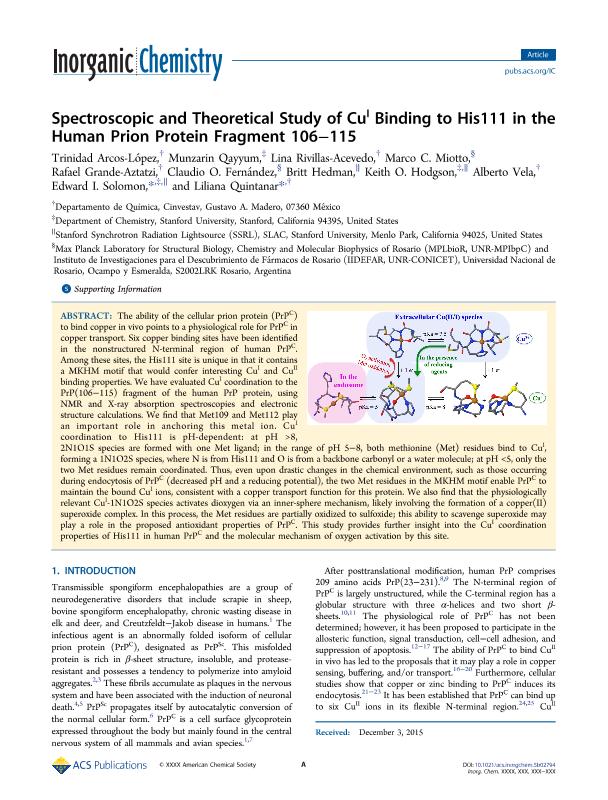Artículo
Spectroscopic and Theoretical Study of CuI Binding to His111 in the Human Prion Protein Fragment 106-115
Arcos López, Trinidad; Qayyum, Munzarin; Rivillas Acevedo, Lina; Miotto, Marco César ; Grande Aztatzi, Rafael; Fernandez, Claudio Oscar
; Grande Aztatzi, Rafael; Fernandez, Claudio Oscar ; Hedman, Britt; Hodgson, Keith O.; Vela, Alberto; Solomon, Edward I.; Quintanar, Liliana
; Hedman, Britt; Hodgson, Keith O.; Vela, Alberto; Solomon, Edward I.; Quintanar, Liliana
 ; Grande Aztatzi, Rafael; Fernandez, Claudio Oscar
; Grande Aztatzi, Rafael; Fernandez, Claudio Oscar ; Hedman, Britt; Hodgson, Keith O.; Vela, Alberto; Solomon, Edward I.; Quintanar, Liliana
; Hedman, Britt; Hodgson, Keith O.; Vela, Alberto; Solomon, Edward I.; Quintanar, Liliana
Fecha de publicación:
03/2016
Editorial:
American Chemical Society
Revista:
Inorganic Chemistry
ISSN:
0020-1669
Idioma:
Inglés
Tipo de recurso:
Artículo publicado
Clasificación temática:
Resumen
The ability of the cellular prion protein (PrPC) to bind copper in vivo points to a physiological role for PrPC in copper transport. Six copper binding sites have been identified in the nonstructured N-terminal region of human PrPC. Among these sites, the His111 site is unique in that it contains a MKHM motif that would confer interesting CuI and CuII binding properties. We have evaluated CuI coordination to the PrP(106-115) fragment of the human PrP protein, using NMR and X-ray absorption spectroscopies and electronic structure calculations. We find that Met109 and Met112 play an important role in anchoring this metal ion. CuI coordination to His111 is pH-dependent: at pH >8, 2N1O1S species are formed with one Met ligand; in the range of pH 5-8, both methionine (Met) residues bind to CuI, forming a 1N1O2S species, where N is from His111 and O is from a backbone carbonyl or a water molecule; at pH <5, only the two Met residues remain coordinated. Thus, even upon drastic changes in the chemical environment, such as those occurring during endocytosis of PrPC (decreased pH and a reducing potential), the two Met residues in the MKHM motif enable PrPC to maintain the bound CuI ions, consistent with a copper transport function for this protein. We also find that the physiologically relevant CuI-1N1O2S species activates dioxygen via an inner-sphere mechanism, likely involving the formation of a copper(II) superoxide complex. In this process, the Met residues are partially oxidized to sulfoxide; this ability to scavenge superoxide may play a role in the proposed antioxidant properties of PrPC. This study provides further insight into the CuI coordination properties of His111 in human PrPC and the molecular mechanism of oxygen activation by this site.
Palabras clave:
Cu(I)
,
Prion Protein
,
Biophysics
Archivos asociados
Licencia
Identificadores
Colecciones
Articulos(CCT - ROSARIO)
Articulos de CTRO.CIENTIFICO TECNOL.CONICET - ROSARIO
Articulos de CTRO.CIENTIFICO TECNOL.CONICET - ROSARIO
Citación
Arcos López, Trinidad; Qayyum, Munzarin; Rivillas Acevedo, Lina; Miotto, Marco César; Grande Aztatzi, Rafael; et al.; Spectroscopic and Theoretical Study of CuI Binding to His111 in the Human Prion Protein Fragment 106-115; American Chemical Society; Inorganic Chemistry; 55; 6; 3-2016; 2909-2922
Compartir
Altmétricas



